
A conjoint analysis is one of the most effective ways to help a brand determine the best product features, benefits, and price combinations.
When measuring the appeal of a new product concept, it can prove challenging to assess the relative value of each benefit properly.
Trying to tackle this through a series of closed-ended questions (select one, select all that apply, ranking) coupled with open-ended questions for context can create a muddy story – one that is hard to apply when deciding on the design of a product.
What is a Conjoint Analysis?
A conjoint analysis in the market research world is a scientific way to better understand consumer behavior and a natural way to replicate how they would choose a product.
Through this approach, the process can be boiled down to a series of questions where you simply ask the customer which of these packages you would be most likely to purchase.
The back-end analysis of conjoint surveys gives the market research firm the option to single out the relative value of each product feature.
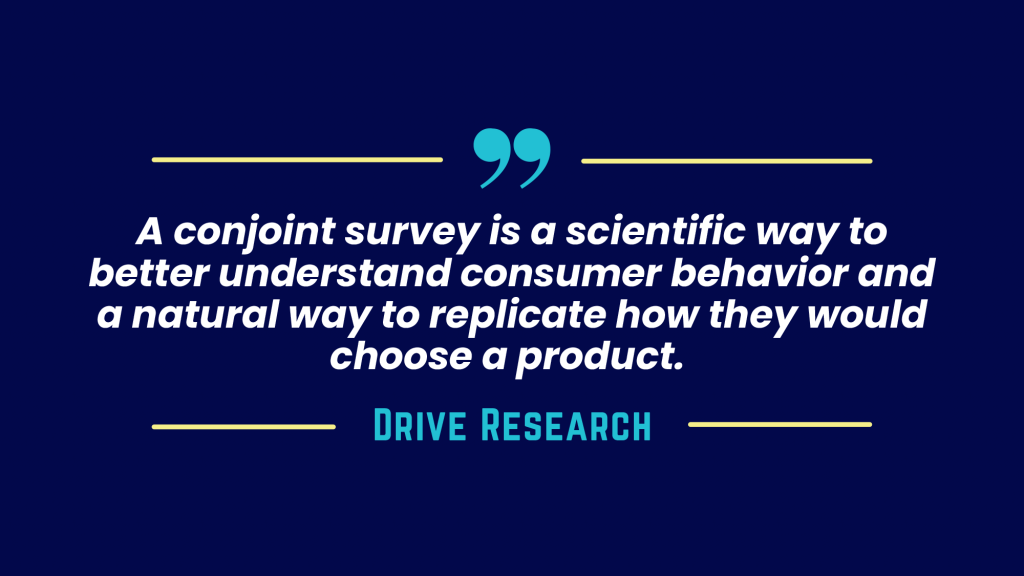
How to Conduct a Conjoint Study
Let’s say you have been tasked with designing a new sport utility vehicle (SUV).
You hire a conjoint analysis company to help you construct the survey, collect data, interpret the results, and recommend the best package of features/benefits to go to market.
Pro Tip: Use qualitative exploratory research as the first step before conducting a conjoint survey. Qualitative research will help you dive deeper into the consumer mindset to help you refine the list of levels and attributes you want to measure. Although qualitative research can serve as an excellent pre-test, it can provide additional context and quotes to supplement your more sophisticated quantitative research.
The first step of a conjoint study is determining the attributes and levels you want to address in your survey.
The attribute is considered as the categories you see below (size, fuel source, etc.), while the levels are the details/options for each category (2WD, AWD, 4WD for the platform).
- Size: Compact SUV, Mid-size SUV, Full-size/extended-length SUV
- Fuel source: Gas-powered, hybrid, fully electric
- Platform: 2WD, AWD, 4WD
- Towing package: Included or not included
- Price: $35,000, $45,000, $55,000, $65,000
How many attributes should I test?
If you are asking about the optimal number of attributes to cover in your conjoint, consider 6 or fewer.
Drive Research recommends striking the right balance between obtaining enough depth to your model and, at the same time, not overwhelming respondents.
Any more and respondents will have difficulty weighing options and might resort to simplification strategies, such as ignoring one attribute altogether.
An expert in this space will recommend the number of sets, cards per set, and attribute levels per set.
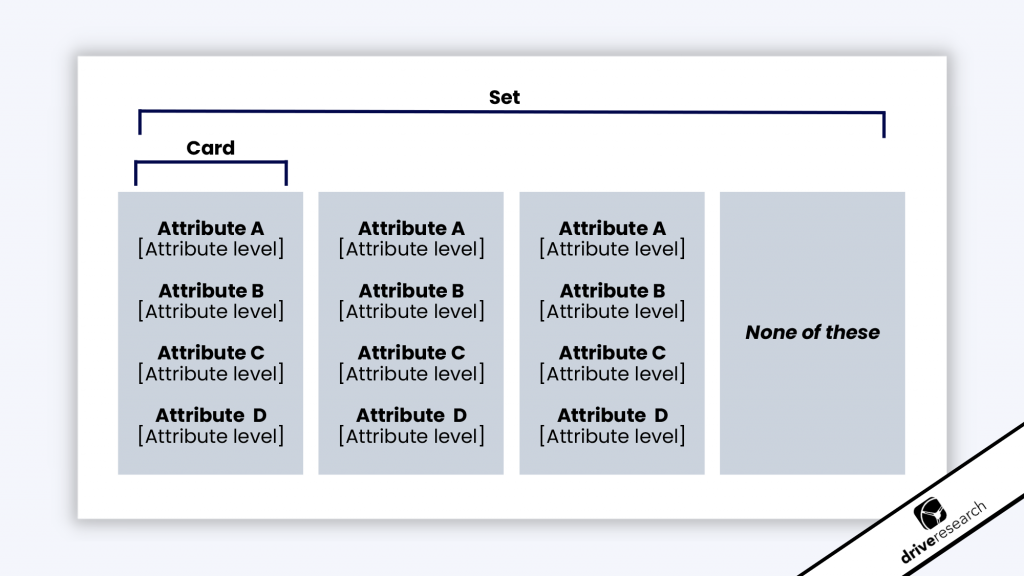
Based on the number of attributes and levels, a market research consultant can help you determine the appropriate number of cards and sets for your CBC design.
The consultant firm can also help design prohibited level pairs.
If the conjoint designed cards were shown randomly with different levels within each attribute and an associated price, the card combinations might not make any sense.
For example, a card may show all of the high-end features of the SUV and add-on packages but would be coupled with the lowest price.
Vice-versa, you may see a card with low-end features/add-ons coupled with the highest price.
Setting up prohibited pairs through logic prevents this.
The survey platform would also prevent duplicate cards or combinations from being shown to the same respondent. It also ensures the sequence of cards being shown all have an equal show rate.
Example Conjoint Analysis Questions
You have a few options to consider for your conjoint design.
A good market research firm can help you understand the pros and cons of each and guide you to the right set.
Additionally, the survey platform will help rotate the levels within each attribute.
Option 1: Single-choice conjoint
The choice-based conjoint analysis is the most simplified way to tackle this type of new product development market research.
In this exercise below, you would ask the respondent which of the following SUV packages you would be most likely to purchase.
The cards include a random mix of levels for each attribute, creating a series of cards. The respondent is asked to choose a single card.
Another option for the single choice is including a fourth card detailing an answer option for none of these.
Doing so helps mirror realistic choices for respondents since they have the option to walk away in the real world.
Therefore, including this option is especially important for testing market potential and even determining product price.
A market research consultant, like Drive Research, can discuss the advantages and disadvantages of offering this as a selection or forcing a respondent to choose one of the provided cards.
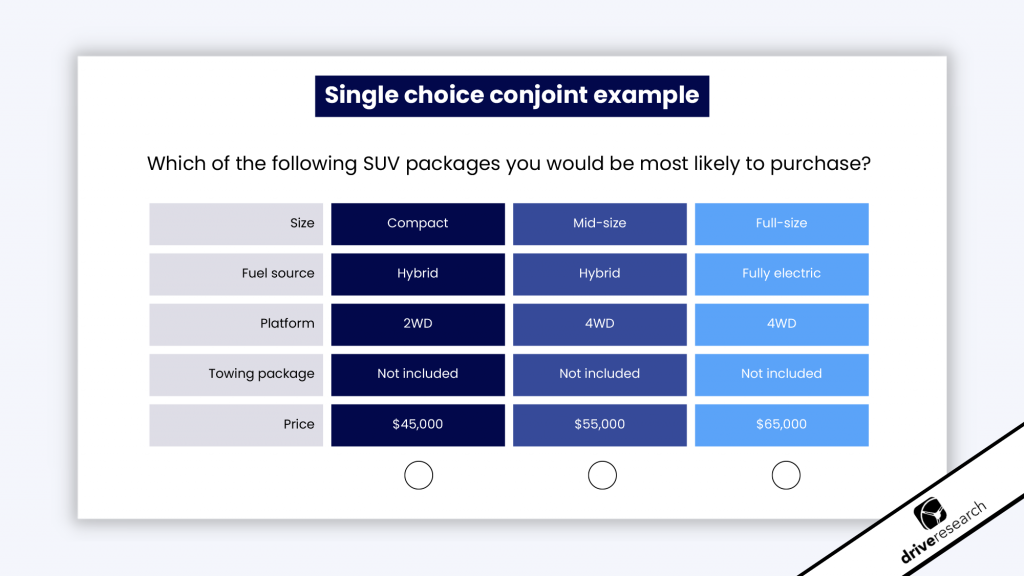
Option 2: Best and worst conjoint
The option for conjoint surveys is similar to the single choice but forces the respondent to make 2 selections in each exercise which includes a best and worst option.
This best and worst conjoint creates an additional layer of variance in the data to create separation of the data versus singling out only the most preferred in the single choice approach in Option 1.
In this option, you ask the respondent which SUV packages they would be most likely to purchase and least likely to purchase.
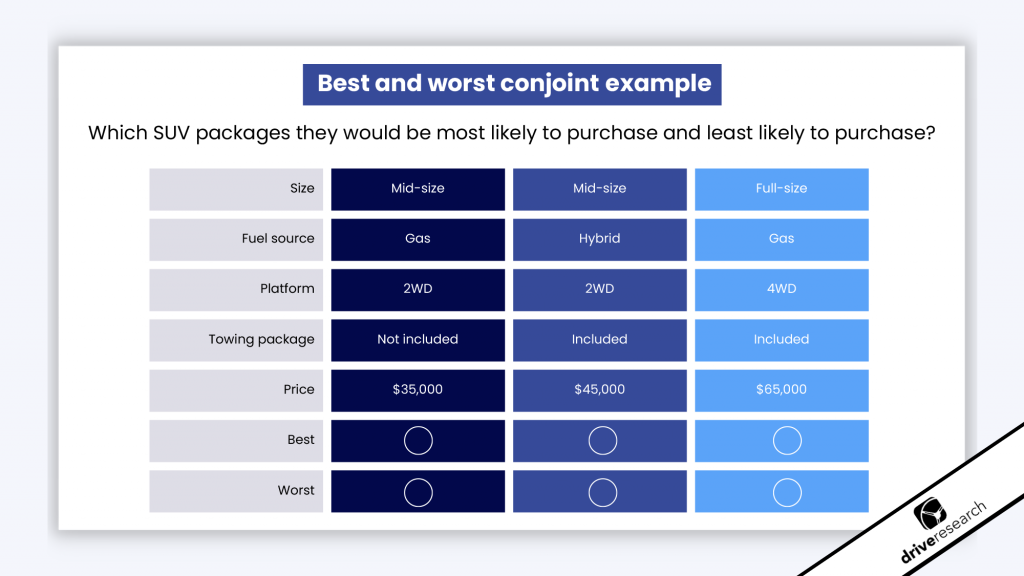
Option 3: Continuous sum
Continuous sum is not always the best option for conjoint studies in market research.
It depends on the product you are offering. Where it makes the most sense is when a consumer owns more than one or decides to purchase multiple in a single shopping experience.
In this example, with an SUV, it’s doubtful a consumer would be buying 2 SUVs at one time.
A better fit for a continuous sum exercise might be a project where you determine the relative value of attributes for a product like frozen dinners, clothes, snacks, etc.
In those cases, you may purchase more than one item where you would spread chips or points across multiple options.
A continuous sum question works when you are allocated a specific number of points or chips (in this case below, and very typically, 100).
The respondent takes those 100 points and enters them to indicate how much they value each card set.
In other words, you may ask the question to the respondent when considering your next 100 purchases, how many purchases would you make of each of the following options?
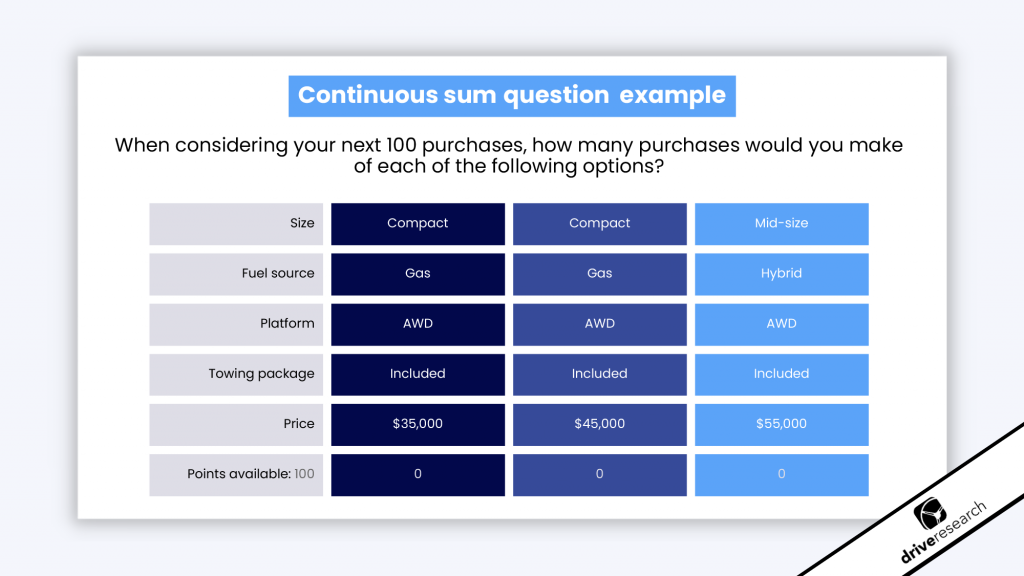
Analyzing Conjoint Survey Data
Once you have set up and run your conjoint survey design, that’s only half the battle. That’s because a big part of the analysis for conjoint is putting together a part-worth utility graph.
The term utility in conjoint is a measure of value or worth for each level. The higher the number for the utility, the more desirable the feature or benefit of the attribute.
Therefore, those levels with the highest utility scores are the ones that will drive respondent choice.
The relative importance of all attributes will always total 100%. This is an excellent indicator to help you interpret which categories are critical to consumer decision-making.
When interpreting both the bar graph and chart below, it is important to note that the value (utility score) is meaningless.
More important is the relative value between the attributes and levels when compared to one another.
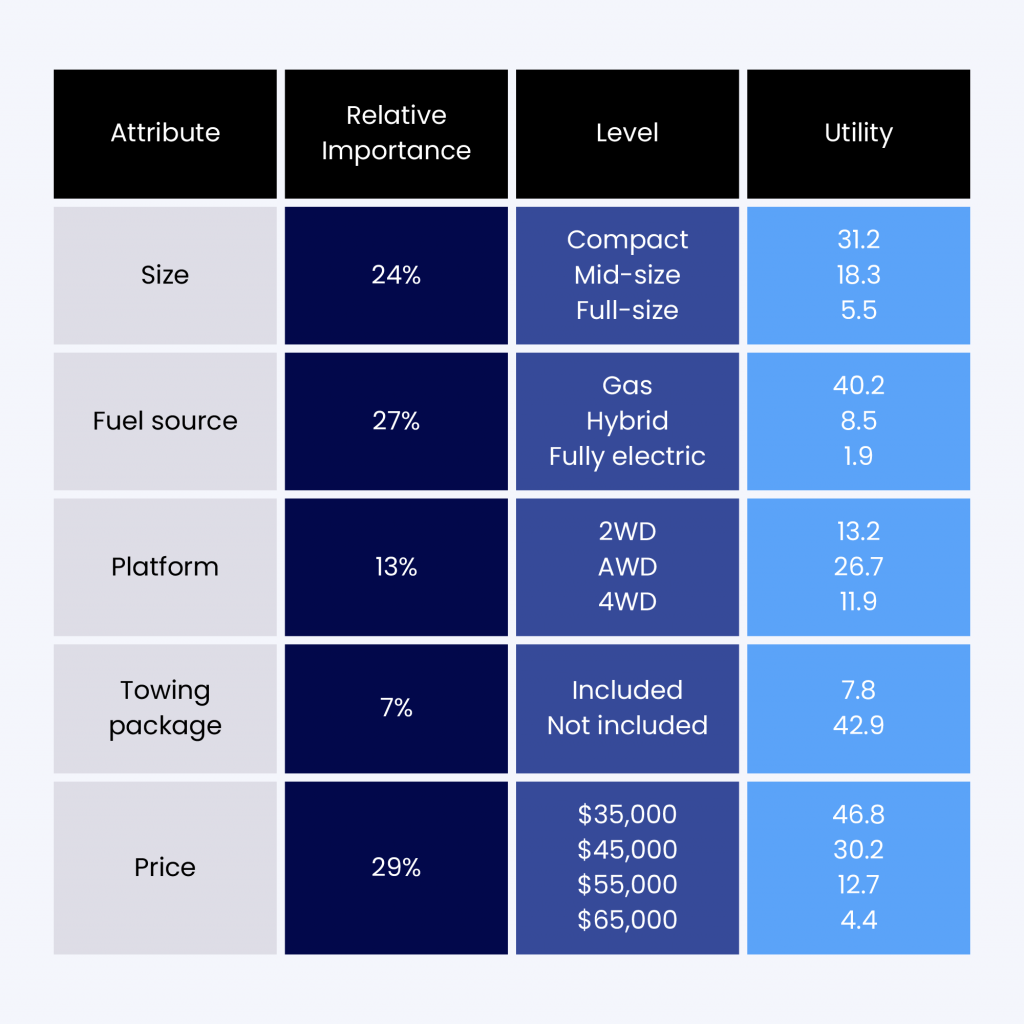
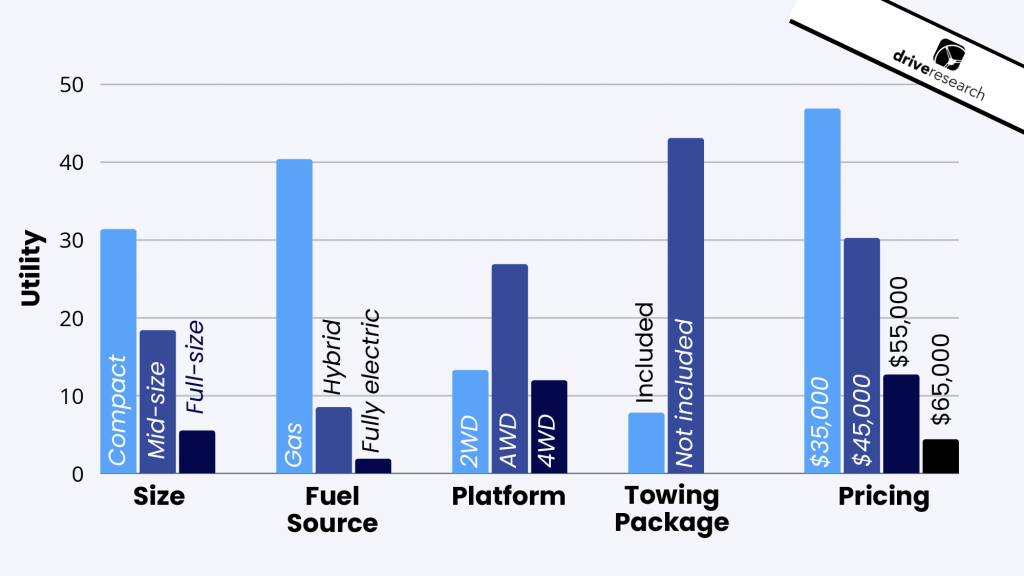
What Does Conjoint Analysis Tell Us?
Conjoint analysis provides a wealth of insights on consumer preferences and how decisions are made. The most straightforward outcomes of conjoint analysis include:
Attribute Importance
At the highest level, conjoint analysis can provide insights on the relative importance of individual product features. Conjoint analysis tells us where consumers place the most value when it comes to decision-making. From our hotel room example, this would tell us the relative importance of room type, leisure activities, dining options, and price.
Utility Values
Conjoint analysis also provides insight into the preference of each level within an attribute. From our hotel room example, this would tell us how much consumers prefer a room with 1 King Bed, compared to 1 Queen Bed, or 2 Queen Beds.
Conjoint analysis can also be much more involved, and address more complex questions organizations might have about their product or service. Some other outcomes of conjoint analysis include:
Market Share Simulations
How would changes to our product or service impact our market share? What combination of features would allow us to maximize market share?
Conjoint analysis can help organizations understand where they stand in the market, and how adjustments to a product will impact market share. Simulations can be run with the overall audience, but also be narrowed down to key audiences (such as by generation or other key segments).
Willingness to Pay
How important is price in overall decision-making? How much are consumers willing to pay for different features? Understanding price sensitivity in the market is vital for organizations. Conjoint analysis can provide insight into the importance of pricing for specific products as well as the perceived value of individual product features.
Segmentation
Are there distinct groups of consumers? What are the preferences of each segment? What behaviors and motivations exist for each segment? Conjoint analysis can be highly valuable when it comes to segmenting consumers and helps organizations with creating effective strategies to reach each segment.
Why Should You Conduct Conjoint Analysis?
Conjoint analysis is critical for organizations looking to better understand what drives decision-making among potential customers.
While conjoint analysis can be more complex and often requires a larger investment, it provides much more value to organizations when compared to traditional research techniques.
Stated preferences from more traditional methods (such as directly asking what factors are most important or having respondents rate attributes on a 1 to 5 Likert scale) can often be unreliable, while simulating real-world buying scenarios through a conjoint exercise is a much better predictor of actual behavior.
With conjoint studies, respondents are forced to consider trade-offs between each product, which leads to better differentiation in data and more reliable results.
Conjoint analysis can also be valuable to a wide range of industries in a variety of situations. A few examples of conjoint analysis providing value include:
- New product development
- Product optimization
- Demand forecasting
- Consumer segmentation & persona development
- Price strategy & revenue optimization
- Marketing & communication strategy
Ultimately, conjoint analysis is a versatile tool that can be used to improve strategic decision-making in any industry. It offers valuable insights into customer preferences, which can be used to make informed decisions about product development, pricing, or marketing.
Market Simulators for Conjoint Analysis
Another key output from a conjoint analysis is a market simulator.
A market simulator is a tool typically in an Excel spreadsheet format that allows you to make quick sense of the part-worth utilities for each attribute.
The market simulator has built-in formulas that make it easy to use.
- Simply adjust the attribute levels for one or more simulated offerings you would like to review.
- The total utility value is then calculated for each offering by automatically summing all the part-worth utilities associated with the attribute levels you selected.
- This lets you assess the relative value of any combination of attribute levels.
You may be thinking, “Can’t I just create an offering that consists of the levels with the highest part-worth utilities for each attribute?
While this would be the “ideal” offering in the eyes of the consumer, it is not always feasible or the most profitable combination.
Here is a great webinar to bookmark by Sawtooth Software that dives into using a market simulator for conjoint surveys.
Benefits of a market simulator
The beauty of a market simulator is that you can see how multiple combinations of attribute levels compare to one another as if they were all on the shelf.
A share is also calculated for each potential offering in real-time to predict what percent of consumers would actually buy it versus the other simulated offerings.
Additionally, you can effectively play around with the attribute levels for each offering in countless scenarios.
These comparisons could include…
- Your business’ own offerings
- Competitive offerings
- New potential offerings
- A combination of the three
The estimated market share for each potential offering can be used to make decisions about introducing a new product, refining your existing product portfolio, or the expected impact of new competitive products.
Conjoint Analysis Case Study
Background
A leading U.S.-based windows and doors manufacturer, known for innovation and market leadership, was preparing to launch a new double-hung window in its entry-level product line. With a portfolio spanning five distinct product lines, the company wanted to assess how this new offering might influence its existing sales mix and impact key competitors. This case study focuses on insights gathered from the professional division, which sells to dealers for new construction and remodeling projects.
Business Challenge
The company faced a familiar but complex question: would this new product expand market share or primarily cannibalize existing sales within its own portfolio? More specifically, the client wanted to measure potential risk to its mid-tier and premium product lines and estimate the share shifts among major competitors.
Research Objectives
To guide strategic decision-making, the research aimed to answer:
- How much cannibalization would the new window cause within the company’s own product lines?
- Would the new offering capture share from competitors, and if so, which brands were most vulnerable?
- Which product features and price points drive consumer preferences in the replacement and remodeling markets?
Methodology: Conjoint-Based Incrementality Modeling
The research was grounded in a choice-based conjoint (CBC) study – a proven statistical technique that simulates real-world trade-offs consumers make when evaluating products. It helps estimate how different features, brands, and prices influence purchase decisions.
Survey Design
Respondents were shown a series of 15 product selection tasks. Each task featured four product options randomly generated from six key attributes, plus a “None” option to simulate a realistic shopping environment:
- Brand: National and regional players including well-known competitors and private-label options
- Style: Single Hung vs. Double Hung
- Material: Composite, Vinyl, and Wood Clad
- Color: Basic (White or Tan) vs. Premium (White, Tan, or Black)
- Glass Performance: Dual Pane vs. Triple Pane
- Price per window: Ranged from $200 to $700 in $100 increments
This design allowed for robust modeling of consumer preference structures, price elasticity, and projected market share.
Key Outcomes
- Cannibalization vs. Competitive Gain: The results showed that the new product would indeed draw some volume from higher-tier internal lines but would also pull significant share from comparable competitor offerings, particularly at mid-range price points.
- Feature Valuation: Consumers placed high importance on material and style, with composite double-hung windows preferred over single-hung or vinyl alternatives.
- Price Sensitivity: While price was a key factor, the model identified several scenarios where consumers were willing to trade up if certain high-value features (like black trim and triple-pane glass) were present.
Strategic Impact
The conjoint model provided a simulated market environment showing how the new product would perform against existing products in the portfolio and among competitors. The insights enabled the client to:
- Optimize product positioning and pricing strategy
- Mitigate internal cannibalization through targeted messaging and packaging
- Quantify expected gains from competitors to support a confident go-to-market strategy
Contact Our Conjoint Analysis Company
Drive Research is a full-service market research company specializing in concept testing and conjoint studies. Our team can recommend the best approach and survey design to execute a successful conjoint study.
To learn more about our services, contact Drive Research today.



